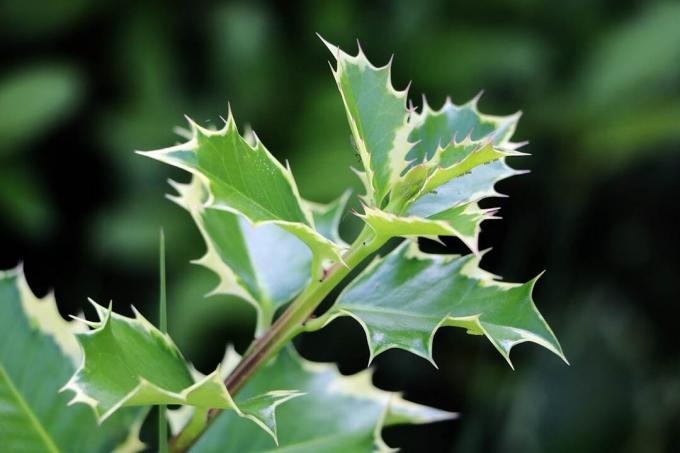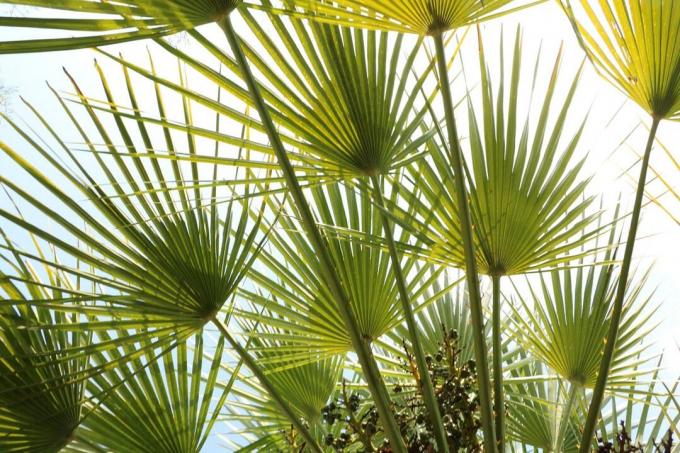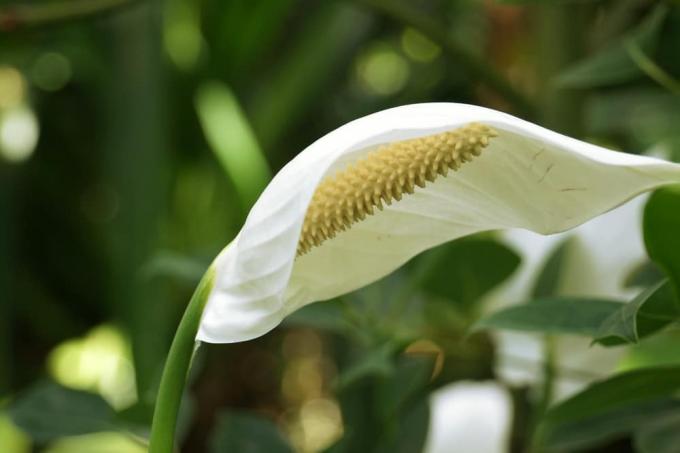

Table of contents
- Location
- plant substrate
- watering & fertilizing
- repot
- Cut
- hibernate
- multiply
- Diseases & Pests
- Are mountain palms poisonous?
- Popular types
The mountain palm has the botanical name Chamaedorea elegans and originally comes from Central America. Thanks to its easy-care and robust properties, the plant has established itself as a popular houseplant in this country. If the site conditions and care are right, the palm tree will thrive. However, certain mistakes in these areas are better avoided, otherwise the plant will only grow poorly.
Location
The mountain palm is native to the mountainous regions of Mexico and Guatemala. The plant grows there mainly as an undergrowth in the light-flooded shade of the forests. Therefore, Chamaedorea elegans prefers a bright location, but it does not cope well with too much sunlight. The plant is ideal as a houseplant for the local latitudes, but due to the lack of winter hardiness, it cannot spend the whole year in the garden. However, the palm feels very comfortable at normal room temperatures. During the warm months, the plant can temporarily move outdoors, it thrives well in sheltered places on the balcony, terrace or in the garden. However, the preferred site conditions should also prevail here.
- Partially sunny places are ideal
- The ideal location is on the east or west window
- Blazing midday heat is not tolerated at all
- Prefers temperatures between 15 and 25°C
- Also copes with partial shade and shade
- But then the palm grows much more slowly and weakly
Tip:
If a south-facing window is selected as the location for the palm tree, then it is dependent on additional sun protection during the midday hours. Pulled down roller shutters, awnings or a blackout curtain are suitable for this.
plant substrate
The conventional garden and potting soil from the trade is not particularly suitable for the mountain palm. Therefore, a suitable mixture of soil and other components should be prepared on your own so that the plant can feel comfortable. If the Chamaedorea elegans has grown a little larger, then it needs more stability in the plant substrate. In addition, the planter must have a sufficiently large drainage hole, otherwise waterlogging can quickly form and the roots will begin to mold.
- A permeable plant substrate is ideal
- Copes well with slightly alkaline pH
- However, it also tolerates slightly acidic soil qualities
- Prefers a mixture of leaf soil, compost and some sand
- For older specimens, mix in loamy garden soil
- Create drainage from potsherds or small pebbles
- Only then spread the plant substrate over it
watering & fertilizing

The mountain palm has a high water requirement during the growing season. In its ancestral homeland, it forms a distinctive root system that reaches down to the groundwater. If the plant is too dry, it will not thrive. The leaves dry out and in extreme cases the palm can even die completely. Anyone who tends to forget to water their houseplants should therefore rely on supplementary water supply systems. In between, the root ball may even be watered too much, but this condition should not be permanent. During the hot months, the planter with the palm tree can be placed in a water bath about every two weeks, this way the roots can completely soak up moisture. When it comes to nutrients, the plant does not have high demands and can cope with conventional fertilizers.
- Pay attention to regular watering units
- Must be watered a lot, especially at high temperatures
- Also tolerates calcareous water from the tap
- However, it is essential to avoid permanent waterlogging
- Spray the palm fronds with water mist from time to time
- Hydroponics or pots with an irrigation system are ideal
- Has normal nutritional requirements
- Fertilize during the growing season from April to the end of August
- Give normal liquid fertilizer twice a month
- However, only use this in half the concentration
Tip:
If the flower pot is placed in a matching saucer, then this saucer should be checked periodically. If excess irrigation water accumulates there, the water must always be removed promptly.
repot
When the mountain palms are still young, they grow much faster. If the site conditions, the care and the substrate are also right, then the planter is quickly too small for the plant. In this case, the plants must be repotted promptly. However, if you use containers that are too large from the start, you will disrupt the growth rhythm of the palm tree. Over time, growth in older specimens is significantly slower. When repotting, extremely careful handling is recommended so that the sensitive root system is not damaged. The palm tree consists of several specimens, which were put together to form small tuffs and then planted in a container. The whole plant never dies when damaged in this way, but the attractive and dense growth habit is often lost when some parts of the plant die.
- Repot only when roots grow out of the pot
- These should look out at the bottom or top
- Do not act too early to avoid disturbing the plant
- Young specimens have to be repotted almost every year
- The best time of year for repotting is early spring
- Slightly taller pots are ideal
- Palm roots grow more in depth than in width
- Always create drainage in the bottom of the pot
Cut
Usually, mountain palms do not need pruning. The plant grows very slowly, but steadily, it can reach heights of growth of up to 150 cm. However, dead plant parts should be removed immediately so that new shoots can develop undisturbed. Since the blossom has a major influence on the growth of the palm tree, it should be removed early if no propagation is desired. Otherwise, the plant puts all its vigor into the formation of the flowers and the growth of the shoots stagnates noticeably.
- Cut off old, brown and withered palm fronds
- Do not cut off too much at once to protect the plant
- Start cutting as low as possible on flower stalks
- Without flowers, palm trees continue to grow normally
hibernate

Mountain palms start hibernating early and then need special treatment when caring for them. Since the plants are not hardy, they cannot spend the whole year outside in the local latitudes. If the palm is outside as a container plant in the summer months, then it must move to a suitable winter quarters. The move must take place in good time before the outside temperatures drop permanently below 10°C. Otherwise, the plant can be damaged if the temperature is too cold. The selected winter quarters should not be too dark, otherwise the shoots will wither and the color of the leaves will fade. In addition, the mountain palm does not get along in heated living rooms in winter, which then becomes more susceptible to pests.
- Hibernation lasts from October to February
- During this phase, room temperatures of 12° to 15° C are ideal
- Good winter quarters are unheated conservatories
- Alternatively, move into bright basement rooms or corridors
- Also feels comfortable in unused guest rooms
- Don't put it too sunny
- Water only a little in winter
- Do not administer fertilizers
- Make sure there is sufficient humidity
- Spray palm regularly with water mist
- Ventilate winter quarters periodically to avoid mold
multiply
Since the mountain palms do not produce fruit as indoor plants, propagation by cuttings is a good idea. If Chamaedorea elegans is outdoors as a container plant, seeds can definitely form. However, this process of reproduction is very difficult and troublesome to carry out.
- Cut off side shoots at the base of the palm tree
- Use germ-free potting soil
- Gently insert cuttings into soil
- Ideal temperature values are 24 to 26° C
- Bright location, but by no means too sunny
- Always keep the soil slightly moist
- Do not fertilize initially
- This stimulates root growth
Diseases & Pests
Diseases are relatively rare in Chamaedorea elegans because the plant is very robust. The palm forgives minor care mistakes, but reacts sensitively to incorrect site conditions and serious deviations in care. If the ambient air is too dry and the location too cool, then the tips of the palm fronds often dry up. If the winter quarters are not suitable, pests will quickly spread. These include scale insects, spider mites and occasionally thrips. As a rule, these pests can be eliminated with harmless home remedies. However, if there is no improvement, then often only chemical pesticides can help. However, these are not well tolerated by the palm trees and permanently weaken the sensitive plants.
- Spider mites can be recognized by their fine webs
- Form these both at the base and at the end of the fronds
- Pests prefer low humidity
- Wash this off with a gentle soapy layer
- Spray affected plants daily with water mist
- Scale insects are tiny and difficult to spot
- Infestation is expressed by secreted honeydew
- Sticky coating around the plant and container, often on the bottom
- Rinse off pests with soapy water
- In extreme cases, use chemical insecticides
- Repeat treatment more often
- This is the only way to destroy all development stages of the pests
Are mountain palms poisonous?

In popular belief, the rumor persists that the mountain palm is poisonous. The flowers and leaves are said to contain harmful saponins, which lead to problems in the stomach and intestines after consumption. However, the Zurich Institute for Veterinary Pharmacology and Toxicology has refuted this misconception. However, parents should always exercise caution, especially when the children are very young. Dogs and cats also like to stay near the palm trees and should not eat them.
- Is not poisonous according to the poisonous plant database
- Is listed there as a harmless plant for living rooms and balconies
- However, children should never play with indoor plants unsupervised
- Dogs and cats should not have contact with the mountain palm
- Avoid this situation by setting it up high
Popular types
In addition to the very popular species Chamaedorea elegans, the genus Chamaedorea includes over 100 other species, most of which are also non-toxic. Some of them grow even larger or significantly smaller, and they also differ in their optical properties. So far, the mountain palm has become the most common indoor plant.
- Chamaedorea metallica has a delicate growth
- Chamaedorea graminifolia forms very long leaves
- Chamaedorea ernesti-augustii is characterized by its featherless leaves
- Chamaedorea elegans Bella is one of the beautiful hybrids
 garden editorial
garden editorial I write about everything that interests me in my garden.
Learn more about Exotic Plants

Holly, holly: care from A to Z
The European holly is one of the evergreen plants. It reaches a height of up to five meters and is ideal as a Christmas decoration or garden shrub. The native, although rarely occurring plant is the only native representative of the Ilex family and is particularly easy to care for and robust.

Dwarf palm, Chamaerops humilis: care instructions
The dwarf palm remains small enough that it can also be cared for in the room. However, it also cuts a fine figure in the garden. You can find out here how it is maintained and what needs to be considered.

Dwarf date palm, Phoenix roebelenii: Care from A-Z
The dwarf date palm (Phoenix roebelenii) is a particularly small, actually the smallest palm species of its genus. But that doesn't make them any less decorative. It is the most filigree and elegant date palm and hardly grows higher than one meter.

Growing vanilla plants: 11 tips for care
The vanilla plant is truly exotic in Central Europe and cannot be found in every garden. Vanilla planifolia forms the aromatic pods for which the plant is known. The cultivation of a vanilla plant is easily possible with the right care tips.

Kangaroo Paw: Caring for the kangaroo plant
Kangaroo paws are exotic plants native to southwestern Australia. Considering the care instructions, Kangaroo Paw can also thrive in Central European conditions. Maintenance requires a little more effort. If the plant gets enough attention, it will thank you with magnificent inflorescences.

Einblatt, Spathiphyllum: care from A to Z
Because of simple! The single sheet draws everyone's attention with its extravagant appearance. The imposing flower gives sophisticated rooms that certain something. If the houseplant is in the right place, hardly any care is required. The breeder can find out here what demands Spathiphyllum places on their location.
